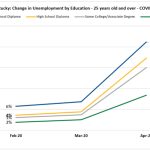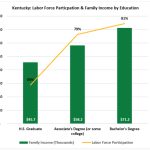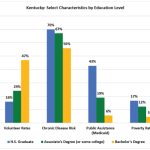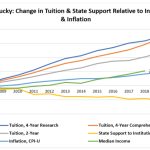Why Affordability Matters
The COVID-19 pandemic has laid bare many inequities in our state and country, not least of which is the impact that one’s education level has on successfully weathering the crisis. Recent data reported by the Federal Reserve illustrates this profoundly – with dramatically higher unemployment rates for those with less education.

These trends are amplified by research released just last month from the Center on Education and the Workforce at Georgetown University. They note much greater loss of income from March to May this year for those with less education, young adults age 18-24, as well as Black and Latino households and those households with already low incomes.
Of course, we already know the long-standing positive impacts educational attainment has on Kentuckians quality of life. From higher incomes and workforce participation, to less chronic disease and lower rates of poverty, the benefits are myriad and significant as noted every year in the University of Kentucky’s Annual Economic Report.


Framing an Affordability Discussion
These data – and as Kentucky’s Council on Postsecondary Education meets next week to finalize tuition rates for the 2021 academic year (three Kentucky institutions are requesting tuition increases – the University of Kentucky, University of Louisville, and the Kentucky Community and Technical College System) – have pushed me to reflect on work we undertook last year to build a better shared understanding of college affordability in Kentucky.
With support from the LuminaTM Foundation’s Strategy Labs, we convened a group of stakeholders representing students, institutions, advocates, community groups, and policy makers, to explore this big question – How can Kentucky better define postsecondary affordability?
We approached this question with the belief that shared understanding of what affordability means is critical to crafting new solutions. And recognizing the shared responsibility of all stakeholders in overcoming financial barriers and ensuring student success.
Moreover, staying on track to meet Kentucky’s 2030 attainment goal demands that we continue to break down barriers to college access and ensure higher education remains affordable for all citizens.
Affordability trends have not been promising. Rising tuition prices, declining state support for higher education, increasing student debt levels, growing negative public perceptions of college cost and value, and stagnant wage growth are threatening to erode college access, particularly for lower-income students, part-time learners, and working adults.
Consider the following trends:
From 2008 through 2020, Kentucky’s state support to public colleges and universities declined 21%, or over $220 million. During the same period, tuition costs increased 51% at public 2-year colleges, 71% at public 4-year regional campuses, and 73% at public 4-year research campuses.

SOURCE: Kentucky Council on Postsecondary Education Tuition Tables; American Community Survey 1-Year Estimates, Table B19013; Bureau of Labor Statistics CPI Supplemental Files.
These same trends show up in the rising share of revenue to campuses from tuition, and declining share from state support. Students have been increasingly picking up the tab, rising from just over a third in 2008 to over half in 2019.

SOURCE: State Higher Education Finance Report, 2019, https://shef.sheeo.org/report/.
Moreover, from 2008 to 2018, the average debt for Kentucky students with loans at 4-year public colleges has increased over 75%, while the number of students with loan debt has steadily risen.

SOURCE: The Institute for College Access & Success, College InSight, http://www.college-insight.org.
There is also concern on the equity front. According to a 2015 Student Debt report by the Council on Postsecondary Education, both low-income and African-American students incur more debt than their counterparts.

SOURCE: Kentucky Council on Postsecondary Education, Student Loan Debt in Kentucky, 2015.
Add to these data pointing to real financial challenges, the fact that many Kentuckians have a perception that college costs too much and the value of a degree may be eroding. In our 2019 Education Poll of Kentucky, 77% of Kentuckians responded that tuition is too high – while 33% felt a 4-year degree is not worth the cost.
One can imagine these challenges impacting students’ decisions to pursue postsecondary education. This is showing in our Kentucky college-going data for recent high school graduates, as well as the number of adults enrolling. Both have which are on the decline as noted in the Council on Postsecondary Education’s most recent progress report.
It’s hard to look at these trends and not think that building a shared understanding of what affordability means is a critical step in guiding public investment and helping a diverse set of stakeholders support students understand the possible pathways to achieving a degree or credential. This is all the more evident given the COVID-19 pandemic and many of the costs that it has laid bare – many basic needs for students – such as health care, housing, food, child care, and access to technology.
In Part II of this post, we’ll explore more about what we learned in our discussions last year about defining and modeling affordability. In part III, we’ll highlight some innovative ways Kentucky institutions are supporting student success and point forward to what questions lie ahead.




Comments are closed.